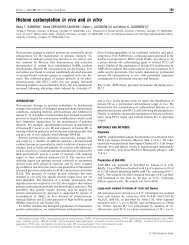Mechanism of horseradish peroxidase inactivation by benzhydrazide
Mechanism of horseradish peroxidase inactivation by benzhydrazide
Mechanism of horseradish peroxidase inactivation by benzhydrazide
You also want an ePaper? Increase the reach of your titles
YUMPU automatically turns print PDFs into web optimized ePapers that Google loves.
620 S. M. Aitken and others<br />
reflected in large part in the equilibrium K d values [31] since<br />
the K I /K d ratios are approx. 0.1–10 with a few exceptions, most<br />
notably 3-NH 2 -BZH (Table 1). None <strong>of</strong> the ring substituents<br />
decreased the K d or K I values <strong>of</strong> the hydrazides in comparison<br />
with BZH (Figure 2). The relatively low K I value for 2-NZH (2-<br />
naphthoichydrazide; 0.014 mM, Table 1) suggests that the diazene<br />
(compound 3) and/or the naphthoyl radical (compound 5) derived<br />
from 2-NZH bind HRPC more tightly than those <strong>of</strong> the other<br />
hydrazides, which would be consistent with the low K d (5.2 µM,<br />
Table 1) <strong>of</strong>2-NZH. With the exception <strong>of</strong> 3-NO 2 -BZH, the IC 50<br />
values for the meta-andpara-substituted hydrazides vary <strong>by</strong> only<br />
3-fold or less. Substituents in the ortho-position result in increased<br />
IC 50 values (Table 1), which is likely to be due to the confined<br />
active site <strong>of</strong> HRPC [38].<br />
The high IC 50 and low k inact values for HRPC inhibition <strong>by</strong><br />
the aromatic hydrazides in Table 1 suggest that the design <strong>of</strong><br />
an HRPC-selective hydrazide inhibitor will be challenging. Tight<br />
inhibitor binding is important since the additional phenyl ring<br />
<strong>of</strong> 2-NZH lowers the IC 50 and K d values <strong>by</strong> 28- and 23-fold,<br />
respectively, relative to BZH. Addition <strong>of</strong> polar ring substituents<br />
will be desirable for solvation <strong>of</strong> larger aromatic hydrazides<br />
and selectivity will be promoted <strong>by</strong> the placement <strong>of</strong> the ring<br />
substituents. For example, substituents ortho to the hydrazide<br />
group are expected to decrease HRPC selectivity (Table 1).<br />
Comparison with MPO inhibition <strong>by</strong> 4-NH 2 -BZH plus H 2 O 2<br />
The inhibition <strong>of</strong> MPO <strong>by</strong> aromatic hydrazides has also been<br />
investigated in detail [8–10]. These compounds are more effective<br />
inhibitors <strong>of</strong> MPO [10], and the IC HRPC<br />
50<br />
/IC MPO<br />
50<br />
ratios range from<br />
8 (4-chloro<strong>benzhydrazide</strong>) to 1100 (4-NH 2 -BZH). The high<br />
selectivity <strong>of</strong> 4-NH 2 -BZH for MPO is encouraging since it<br />
suggests that the design <strong>of</strong> <strong>peroxidase</strong>-specific aromatic hydrazide<br />
inhibitors may be feasible. Also, the relatively low IC 50 values<br />
for MPO [10] suggest that to design hydrazide inhibitors<br />
with high affinities should be possible. This would prevent<br />
modification <strong>of</strong> other biomolecules and free radical generation<br />
<strong>by</strong> release <strong>of</strong> activated intermediates from <strong>peroxidase</strong>s. Thus<br />
further investigation <strong>of</strong> the inhibition <strong>of</strong> mammalian <strong>peroxidase</strong>s<br />
<strong>by</strong> hydrazides should provide tools to better define the roles <strong>of</strong><br />
these enzymes in vivo.<br />
S. M. A. was supported <strong>by</strong> MRC/PMAC Health Program and NSERC Studentships.<br />
REFERENCES<br />
Scheme 2 <strong>Mechanism</strong> <strong>of</strong> BZH oxidation and modification <strong>of</strong> the haem <strong>of</strong><br />
HRPC (based on [2])<br />
For details see the Discussion.<br />
shown). In fact, the peroxy radical, formed <strong>by</strong> the addition <strong>of</strong> O 2<br />
to the acyl radical, has been reported as a major product <strong>of</strong> INH<br />
oxidation <strong>by</strong> HRPC [13].<br />
Kinetics <strong>of</strong> HRPC <strong>inactivation</strong> <strong>by</strong> monosubstituted arylhydrazides<br />
plus H 2 O 2<br />
Table 1 summarizes K I , k inact and IC 50 values for HRPC inhibition<br />
<strong>by</strong> the 21 hydrazides tested. These data demonstrate that the selected<br />
hydrazides are clearly not efficient inactivators <strong>of</strong> HRPC. Nonetheless,<br />
the kinetic parameters vary approx. 5000-fold (Table 1),<br />
indicating that the aromatic ring and its substituents are important<br />
determinants <strong>of</strong> efficiency and specificity. The variation in K I is<br />
1 Ortiz de Montellano, P. R. (1995) Arylhydrazines as probes <strong>of</strong> hemoprotein structure and<br />
function. Biochimie 77, 581–593<br />
2 Ator, M. A. and Ortiz de Montellano, P. R. (1987) Protein control <strong>of</strong> prosthetic heme<br />
reactivity. Reaction <strong>of</strong> substrates with the heme edge <strong>of</strong> <strong>horseradish</strong> <strong>peroxidase</strong>.<br />
J. Biol. Chem. 262, 1542–1551<br />
3 Ator, M. A., David, S. K. and Ortiz de Montellano, P. R. (1989) Stabilized isoporphyrin<br />
intermediates in the <strong>inactivation</strong> <strong>of</strong> <strong>horseradish</strong> <strong>peroxidase</strong> <strong>by</strong> alkylhydrazines.<br />
J. Biol. Chem. 264, 9250–9257<br />
4 DePillis, G. D. and Ortiz de Montellano, P. R. (1989) Substrate oxidation <strong>by</strong> the heme edge<br />
<strong>of</strong> fungal <strong>peroxidase</strong>s. Reaction <strong>of</strong> Coprinus macrorhizus <strong>peroxidase</strong> with hydrazines and<br />
sodium azide. Biochemistry 28, 7947–7952<br />
5 DePillis, G. D., Wariishi, H., Gold, M. H. and Ortiz de Montellano, P. R. (1990) Inactivation<br />
<strong>of</strong> lignin <strong>peroxidase</strong> <strong>by</strong> phenylhydrazine and sodium azide. Arch. Biochem. Biophys. 280,<br />
217–223<br />
6 Harris, R. Z., Wariishi, H., Gold, M. H. and Ortiz de Montellano, P. R. (1991) The catalytic<br />
site <strong>of</strong> manganese <strong>peroxidase</strong>. Regiospecific addition <strong>of</strong> sodium azide and alkylhydrazines<br />
to the heme group. J. Biol. Chem. 266, 8751–8758<br />
7 Samokyszyn, V. M. and Ortiz de Montellano, P. R. (1991) Topology <strong>of</strong> the<br />
chloro<strong>peroxidase</strong> active site: regiospecificity <strong>of</strong> heme modification <strong>by</strong> phenylhydrazine<br />
and sodium azide. Biochemistry 30, 11646–11653<br />
c○ 2003 Biochemical Society








